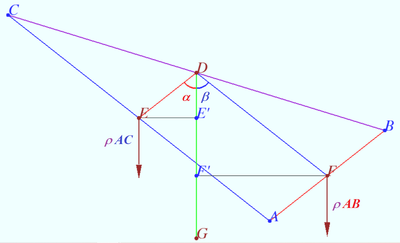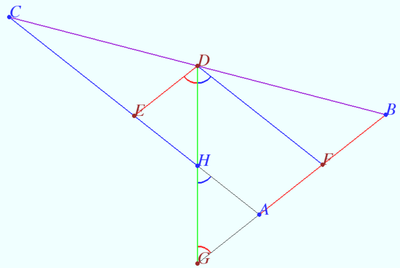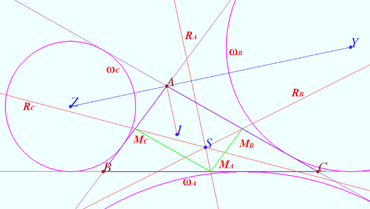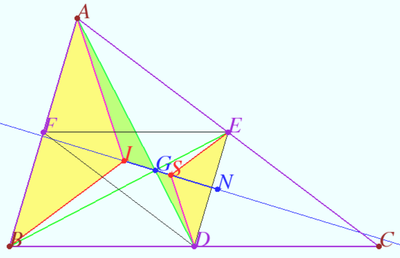Spieker center
The Spieker center is defined as the center of mass of the perimeter of the triangle. The Spieker center of a ![]() is the center of gravity of a homogeneous wire frame in the shape of
is the center of gravity of a homogeneous wire frame in the shape of ![]() The Spieker center is a triangle center and it is listed as the point
The Spieker center is a triangle center and it is listed as the point ![]()
Contents
Incenter of medial triangle
Prove that the Spieker center of triangle ![]() is the incenter of the medial triangle
is the incenter of the medial triangle ![]() of a
of a ![]()
Proof
Let's hang up the ![]() in the middle of side
in the middle of side ![]() Side
Side ![]() is balanced.
is balanced.
Let's replace side ![]() with point
with point ![]() (the center of mass of
(the center of mass of ![]() the midpoint
the midpoint ![]() Denote
Denote ![]() the linear density of a homogeneous wire frame.
the linear density of a homogeneous wire frame.
The mass of point ![]() is equal to
is equal to ![]() the shoulder of the gravity force is
the shoulder of the gravity force is ![]()
The moment of this force is ![]()
Similarly the moment gravity force acting on AB is ![]()
Therefore, equilibrium condition is ![]() and the center of gravity of a homogeneous wire frame
and the center of gravity of a homogeneous wire frame ![]() lies on each bisector of
lies on each bisector of ![]()
This point is the incenter of the medial triangle ![]()
vladimir.shelomovskii@gmail.com, vvsss
Intersection of three cleavers
Prove that the Spieker center is located at the intersection of the three cleavers of triangle. A cleaver of a triangle is a line segment that bisects the perimeter of the triangle and has one endpoint at the midpoint of one of the three sides.
Proof
We use notation of previous proof. ![]() is the segment contains the Spieker center,
is the segment contains the Spieker center, ![]() WLOG,
WLOG, ![]()
![]() Similarly,
Similarly, ![]()
So ![]() is cleaver.
is cleaver.
Therefore, the three cleavers meet at the Spieker center.
vladimir.shelomovskii@gmail.com, vvsss
Radical center of excircles
Prove that the Spieker center of triangle is the radical center of the three excircles.
Proof
Let ![]() be given,
be given,![]() be the midpoints of
be the midpoints of ![]() respectively.
respectively.
Let ![]() be A-excircle, B-excircle, C-excircle centered at
be A-excircle, B-excircle, C-excircle centered at ![]() respectively.
respectively.
Let ![]() be the incenter of
be the incenter of ![]() Let
Let ![]() be the radical axis of
be the radical axis of ![]() and
and ![]() be the radical axis of
be the radical axis of ![]() and
and ![]() be the radical axis of
be the radical axis of ![]() and
and ![]() respectively.
respectively.
It is known that the distances from ![]() to the tangent points of
to the tangent points of ![]() is equal to the distances from
is equal to the distances from ![]() to the tangent points of
to the tangent points of ![]() therefore
therefore ![]() lies on the radical axis
lies on the radical axis ![]() of
of ![]() and
and ![]() Similarly,
Similarly, ![]()
![]() is cleaver. Similarly,
is cleaver. Similarly, ![]() and
and ![]() are cleavers.
are cleavers.
Therefore the radical center of the three excircles coinside with the intersection of the three cleavers of triangle.
vladimir.shelomovskii@gmail.com, vvsss
Nagel line
Let points ![]() be the incenter, the centroid and the Spieker center of triangle
be the incenter, the centroid and the Spieker center of triangle ![]() respectively. Prove that points
respectively. Prove that points ![]() are collinear,
are collinear, ![]() and the barycentric coordinates of S are
and the barycentric coordinates of S are ![]()
The Nagel line is the line on which points ![]() and Nagel point
and Nagel point ![]() lie.
lie.
Proof
Let ![]() be the midpoints of
be the midpoints of ![]() respectively.
Bisector
respectively.
Bisector ![]() is parallel to cleaver
is parallel to cleaver ![]()
![]() Centroid
Centroid ![]() divide the median
divide the median ![]() such that
such that ![]()
![]() and points
and points ![]() are collinear.
are collinear.
The barycentric coordinates of ![]() are
are ![]() The barycentric coordinates of
The barycentric coordinates of ![]() are
are ![]()
![]()
![]()
vladimir.shelomovskii@gmail.com, vvsss













